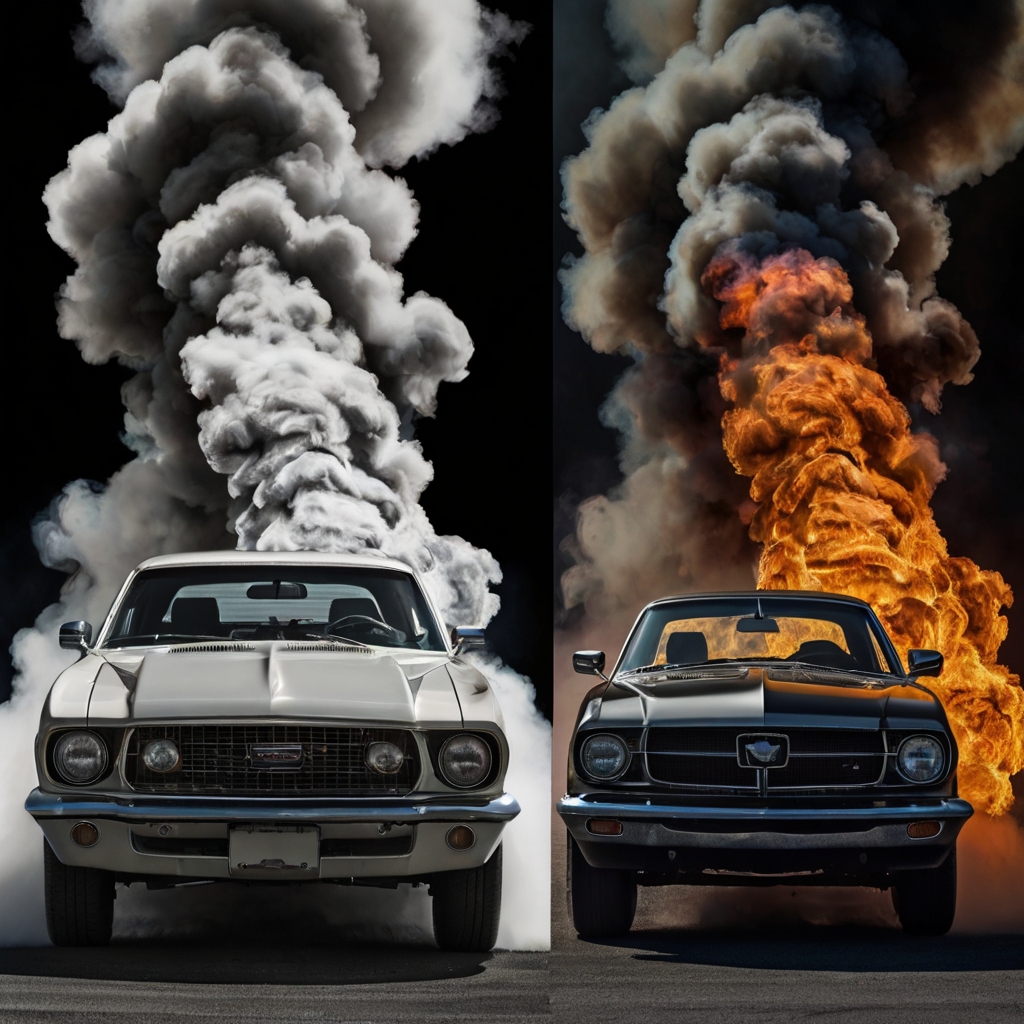White Smoke vs Black Smoke

Your vehicle’s exhaust smoke color is a vital diagnostic tool that reveals engine problems through white and black smoke signals. Expert firefighters read smoke patterns to locate fires and assess dangers. Car owners can use the same principle to identify specific engine issues.
Black and white exhaust smoke tell different stories about your engine’s health. White smoke usually means water vapor but could indicate burning coolant in severe cases. Black exhaust smoke suggests a rich fuel-air mixture from clogged injectors or a dirty air filter. Blue or gray smoke from your tailpipe points to oil burning because of leaky valve seals or worn piston rings. The Vatican uses a similar color-coded system during papal conclaves. Chemical compounds create distinct white or black smoke – a tradition that started in 1914.
This piece explains smoke color meanings and appropriate actions to take once your vehicle shows these warning signs.

Table of Contents
- 1 White Smoke: When It’s Harmless and When It’s Not
- 2 Black Smoke: Fuel System Issues You Shouldn’t Ignore
- 3 Blue or Gray Smoke: The Warning Sign of Burning Oil
- 4 Gray Smoke: A Mix of Problems or Just Confusion?
- 5 What to Do When You See Smoke from Your Tailpipe
- 6 Understanding Your Engine’s Smoke Signals: The Road to Preventive Maintenance
- 7 Here are some FAQs about white smoke vs black smoke:
- 7.1 Is black smoke worse than white smoke?
- 7.2 What is the difference between white smoke and black smoke at the Vatican?
- 7.3 What is the difference between white smoke and dark smoke?
- 7.4 What does it mean when smoke is black?
- 7.5 Is white smoke OK for smoking?
- 7.6 Is Black smoke rare?
- 7.7 How bad is black smoke?
White Smoke: When It’s Harmless and When It’s Not
Many drivers panic at the sight of white smoke from their exhaust. Understanding the difference between harmless condensation and serious engine problems can save money and prevent unnecessary worry. The context and careful observation of white smoke help determine if you need mechanical intervention.
Condensation vs coolant burning
White exhaust smoke usually means water vapor – a natural byproduct of combustion. Cold mornings cause condensation inside the exhaust system. This creates visible white vapor that goes away as the engine warms up. This temporary issue lasts about 10 minutes and becomes more noticeable in cold weather.
Burning coolant creates white smoke that needs immediate attention. Unlike condensation, coolant smoke is thicker and has a sweet smell from ethylene glycol. The smoke stays visible no matter what the engine temperature is. This happens when coolant leaks into combustion chambers through damaged head gaskets, cracked cylinder heads, or a warped engine block.
How to tell the difference
You can spot the difference between harmless condensation and serious coolant issues through these signs:
- Look at the smoke’s density – water vapor looks thin and clears quickly, while coolant smoke is thick and billowy
- Notice any sweet, syrupy smell that indicates coolant
- Track how long the smoke lasts – condensation clears in minutes while coolant smoke stays
- Keep an eye on engine temperature – coolant leaks often cause overheating
- Monitor coolant levels – steady drops suggest internal leakage
The timing gives away important clues. Morning startup condensation disappears fast. Coolant-related smoke gets worse once the engine reaches its working temperature.
Common causes of thick white smoke
Thick white smoke points to several issues beyond normal condensation. A blown head gasket is one of the most common causes. It lets coolant seep into combustion chambers. Cracked cylinder heads or engine blocks can also create paths where coolant shouldn’t go.
Diesel engines might show white smoke due to fuel timing problems, injector issues, or low compression. Clogged fuel filters or failing fuel pumps often cause white smoke during acceleration in diesel vehicles.
Burning transmission fluid creates white-to-grayish smoke with a distinct burnt smell. This happens when transmission fluid leaks onto hot exhaust parts.
Why white smoke can mean engine trouble
Thick, persistent white smoke signals serious mechanical issues that need quick attention. Coolant in the combustion chamber causes poor engine performance, worse fuel efficiency, and overheating.
The biggest concern lies in how these problems get worse. A small head gasket leak that makes a little white smoke can get bad faster, and maybe even destroy your engine. Coolant washes away important engine oil, which makes internal parts wear out sooner.
Quick action on white smoke can stop small issues from becoming major repairs. The cost to fix a head gasket early compared to replacing an entire engine shows why you should understand what your exhaust smoke means. Normal condensation isn’t a worry, but persistent white smoke needs a professional mechanic’s diagnosis instead of hoping it fixes itself.

Black Smoke: Fuel System Issues You Shouldn’t Ignore
Black smoke coming from your exhaust suggests fuel system problems, unlike white smoke that usually means coolant or water vapor issues. Your engine isn’t burning fuel properly when you see this dark smoke coming out. Car owners should know what causes black smoke to avoid expensive repairs later.
What causes black smoke from exhaust
Your engine burns too much fuel compared to the air it gets, and that’s what creates black smoke. Here’s what might be wrong:
- Clogged air filters that don’t let enough oxygen reach the combustion chamber
- Malfunctioning fuel injectors that spray too much fuel
- Damaged oxygen sensors that send wrong readings to the engine control unit
- Faulty mass airflow sensors that miscalculate how much air is needed
- Engine computer problems that can’t keep the right fuel-air mix
Older cars with carburetors often make black smoke because the carburetor isn’t adjusted right. Modern fuel-injected engines face similar troubles when injectors get dirty or damaged and don’t spray fuel correctly.
Signs of a rich fuel mixture
Your engine runs rich when it gets too much fuel, and this shows up in more ways than just black smoke instead of white smoke:
Your exhaust smells strongly of fuel because unburned fuel escapes the system. The engine shakes and runs rough at red lights due to the bad fuel mixture. Spark plugs get covered in black, sooty buildup that stops them from working right.
Cars running rich usually fail emissions tests because of high hydrocarbon levels. The check engine light might come on too when the car’s computer spots the problem.
Impact on fuel economy and emissions
Black exhaust creates more problems than just looking bad. Your fuel economy drops by 10-20% because unused gas or diesel just passes through the engine. This wastes both fuel and money every time you drive.
These emissions harm the environment more than normal exhaust. The engine puts out more unburned hydrocarbons and carbon monoxide than environmental standards allow in most places.
Carbon builds up faster inside engine parts and might wear them out sooner. These deposits can mess up how valves work and affect cylinder compression, which makes your engine run even worse.
Fixes: air filter, injectors, sensors
Most black smoke problems have straightforward solutions:
- Air filter replacement – A clean filter lets the right amount of air flow through. This cheap fix needs regular checks, especially in dusty areas.
- Fuel injector cleaning – Professional cleaning or good fuel additives can clear blocked injectors. Bad cases might need new injectors.
- Sensor inspection – Replace oxygen sensors after 60,000-100,000 miles. New sensors help fix rich fuel problems by giving accurate readings.
- Mass airflow sensor cleaning – Special electronic cleaner often fixes these sensors without replacing them.
A mechanic’s scan tool can find the exact cause by reading engine computer codes if black smoke keeps coming back. Some fixes work well as DIY projects, but complex fuel system problems need professional help to avoid making things worse.
Blue or Gray Smoke: The Warning Sign of Burning Oil
Blue or gray smoke from your tailpipe points to a different issue than white or black smoke. Your engine burns oil when this happens, and you need to fix it quickly before repairs get pricey.
What does blue smoke from exhaust mean
Your vehicle burns oil in the combustion chamber when blue smoke comes from the exhaust. This differs from white smoke (water vapor or coolant) and black smoke (excess fuel). The smoke looks bluish-gray and you might smell burning oil inside your car while driving.
The smoke’s timing helps diagnose the problem. Damaged piston rings show up as blue smoke during acceleration. The smoke during deceleration points to cylinder head valve guide issues. Diesel vehicles might show blue-white smoke at startup from a bad glow plug, but this clears once the engine warms up.
Oil leaks and worn engine parts
Oil can leak through several worn parts:
- Worn piston rings leave gaps between pistons and cylinder walls that let oil seep into combustion chambers
- Valve seal leakage happens when heat cracks high-strength rubber seals
- Cylinder wall damage lets oil burn during combustion
- Blown head gasket mixes oil with fuel and air
- Turbocharger problems leak oil into the intake manifold in turbocharged engines
The positive crankcase ventilation (PCV) system can cause major oil blowback if clogged instead of removing combustion gasses. A simple PCV valve replacement often fixes this issue.
How to check for oil loss
Regular oil level checks catch problems early. Cars with dipsticks need a simple check – pull it out, wipe it clean, put it back, then see if oil stays above the minimum line. Low levels despite regular top-ups suggest internal consumption.
Dark puddles under your parked car often mean external leaks. Internal oil burning usually creates a burning smell while driving. Note that some oil loss happens inside the engine without visible external signs.
When to see a mechanic
Visit a professional right away if you notice:
- Blue smoke coming from your exhaust
- Oil levels dropping faster between changes
- Check engine light coming on
- Rough idling or vibrations
- Blue smoke with decreased performance
Newer vehicles under 50,000 miles should use no more than a quart of extra oil between changes. More consumption than this needs professional attention. Ignoring blue smoke leads to poor engine performance, higher emissions, and damage to crucial engine parts—or complete engine failure.
Gray Smoke: A Mix of Problems or Just Confusion?
Gray smoke creates the most puzzling diagnostic challenge of all exhaust emissions. Black and white smoke give clearer signs of problems, but gray exhaust often points to many issues at once. This makes it a real mechanical mystery.
What gray smoke might indicate
Gray smoke usually shows a mix of problems instead of one clear issue. We noticed it mainly suggests oil burning in the engine, though not as badly as when you see blue smoke. A minor oil leak often creates gray smoke, while blue smoke shows much more oil consumption. Your turbocharger might also be failing when gray smoke appears. Gray exhaust smoke shows up less than other colors but proves the hardest to figure out.
Transmission fluid burning
Transmission fluid leaking into the combustion chamber causes a specific type of gray smoke. This happens when the automatic transmission vacuum modulator diaphragm fails. You can check this by looking at the vacuum hose connection to the transmission’s diaphragm port after your car sits unused for about a week. If transmission fluid drips from this connection, you’ve found your problem.
Burnt transmission fluid smells different from engine oil. Both give off a burnt oil smell, but transmission fluid makes white-to-gray smoke instead of blue. You’ll often notice a strong burning smell when you change gears.
PCV valve issues
A bad Positive Crankcase Ventilation (PCV) valve often leads to gray exhaust smoke. This key emissions control device pulls unburnt fuel from the bottom of the engine back to the top. PCV valves wear out over time and make smoke that looks serious, but the fix is pretty simple.
Car owners report the smoke goes away completely when they disconnect the PCV valve tube, which confirms this diagnosis. The system can pull oil or oil vapor straight into the intake when too much vacuum builds up at this port.
Why diagnosis can be tricky
Gray smoke proves hard to diagnose because it falls between other smoke colors. It might show oil burning (like blue smoke), coolant problems (like white smoke), or fuel issues (like black smoke). The color looks different at times – sometimes bluish-gray, other times whitish-gray – based on what’s causing it and how the light hits it.
Gray smoke also tends to come from several problems happening at once. Mechanics need to rule out each possible cause step by step rather than spot one obvious issue right away.
What to Do When You See Smoke from Your Tailpipe
Smoke coming from your tailpipe needs quick attention. You should know the difference between urgent smoke signals and minor issues that can wait. This knowledge could save your engine and your wallet. Your dashboard usually gives you the first important clues about how serious the problem might be.
Check engine light and dashboard warnings
A check engine light with smoke is a serious warning you should never ignore. This combination usually points to an emissions problem that could destroy your engine if you don’t fix it. Your dashboard shows other important warnings too:
- White smoke with overheating indicators points to coolant problems
- Electrical system issues often trigger battery warning lights
- Blue smoke with oil pressure warnings shows your engine burns oil
Mechanics warn that driving with active warning lights can turn small problems into expensive repairs.
When to keep driving vs pull over
You should stop your car and shut off the engine if:
- Thick white smoke appears in warm weather (your engine burns coolant)
- Black smoke pours out steadily (your fuel system has serious problems)
- Your engine shakes or loses power with any smoke
You can usually keep driving carefully when:
- Thin white vapor shows up briefly on cold mornings (this is normal condensation)
- Small amounts of smoke go away after your engine warms up
Any color smoke that doesn’t go away needs a mechanic’s attention, even if it’s not an emergency right now.
How to document symptoms for your mechanic
Good documentation helps your mechanic find problems faster:
- Write down the exact color (white vs black smoke, blue/gray shades)
- Track when the smoke appears (during startup, speeding up, slowing down)
- Check how thick the smoke is (thin vapor or heavy clouds)
- Notice any strange engine sounds with the smoke
- Check for specific smells (sweet coolant smell or strong fuel odor)
Your mechanic can diagnose better if you take photos or videos of the smoke. A good record of these details makes it easier to find and fix the problem.
Understanding Your Engine’s Smoke Signals: The Road to Preventive Maintenance
Your vehicle’s smoke signals need immediate attention, whatever their color. This piece decodes what your engine tells you through its exhaust. White smoke shows water vapor or serious coolant issues. Black smoke points to fuel system problems. Blue smoke signals oil consumption, and gray smoke suggests multiple potential issues at once.
Without doubt, watching your exhaust acts as an early warning system for mechanical problems. So drivers who spot these smoke signals can fix issues before they turn into major repairs. The ability to tell normal operation from serious conditions helps owners decide when they need professional help.
On top of that, smoke patterns and timing offer vital clues for diagnosis. To name just one example, white vapor on cold mornings is often just harmless condensation. But thick white smoke at normal driving temperatures means coolant has entered the combustion chambers. Black smoke during acceleration hints at fuel delivery problems, while blue smoke suggests worn piston rings or valve seals.
Some exhaust problems need quick fixes, while others can wait for scheduled maintenance. In spite of that, ignoring constant smoke will lead to poor performance, failed emissions tests, and maybe even fatal engine damage. Looking at smoke as your vehicle’s way of communicating rather than a nuisance will give your engine a longer life and more reliable transportation.
Recording smoke traits – color, density, smell, and timing – helps mechanics find problems quickly. This knowledge gives vehicle owners the ability to talk confidently with automotive experts and make smart maintenance choices. Your engine shows its health through these visual signals, and learning to read them right saves both your vehicle and your wallet from extra stress.
Here are some FAQs about white smoke vs black smoke:
Is black smoke worse than white smoke?
Yes, black smoke is generally worse than white smoke, especially in a fire situation. When comparing white smoke vs black smoke, black smoke usually indicates incomplete combustion and the presence of toxic substances, such as plastics, rubber, or petroleum-based products. White smoke, on the other hand, often means steam, moisture, or the burning of less dangerous materials, making black vs white smoke a matter of danger and toxicity.
What is the difference between white smoke and black smoke at the Vatican?
At the Vatican, white smoke vs black smoke has symbolic meaning during a papal conclave. Black smoke indicates that no new pope has been elected, while white smoke announces that a new pope has been chosen. This black smoke vs white smoke tradition is achieved by adding specific chemicals to the burning ballots to produce the desired smoke color.
What is the difference between white smoke and dark smoke?
The main difference between white smoke and dark smoke lies in what they indicate about a fire’s contents and combustion. White smoke often comes from materials like water vapor, wood, or other organic matter, while dark or black smoke suggests the presence of synthetic materials or hydrocarbons burning. In the white smoke vs black smoke fire debate, black smoke signals a more dangerous, toxic, and hotter fire.
What does it mean when smoke is black?
When smoke is black, it typically means that the fire is burning synthetic materials or chemicals with incomplete combustion. Black smoke is denser and contains more soot and harmful particles, making it far more dangerous than white smoke. In fire emergencies, what does black smoke mean in a fire often translates to higher toxicity and a need for immediate evacuation.
Is white smoke OK for smoking?
White smoke during smoking, such as in cooking or engines, can be acceptable under certain conditions. However, comparing white smoke vs black smoke, white smoke may still indicate moisture or a cooler burn, while black smoke often means excess fuel and dangerous emissions. While less harmful, even white smoke should be managed carefully depending on the context.
Is Black smoke rare?
Black smoke is not rare, especially in urban or industrial fires where synthetic materials are common. However, black smoke vs white smoke often appears more alarming because of its density and toxic smell. In residential settings, white smoke might appear first, but black smoke quickly follows as more dangerous materials ignite.
How bad is black smoke?
Black smoke is quite bad due to its high concentration of pollutants and toxic chemicals. In the context of white vs black smoke, black smoke indicates a more hazardous fire environment, poor air quality, and potential health risks from inhalation. What does black smoke mean in a fire? It usually means time is running out for safe evacuation.

